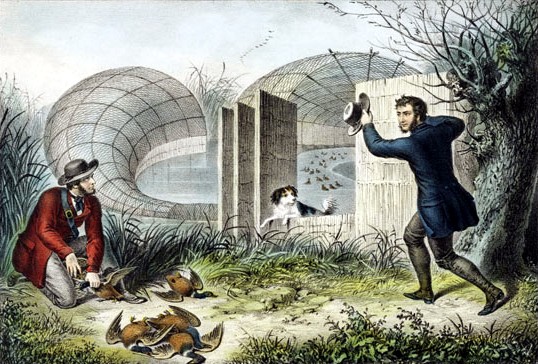|
Duck
decoys
The word decoy is a corruption of duck-coy from the Dutch word kooi, a cage or pen, and it was this method of capturing wildfowl that was introduced into England from Holland and remained unaltered for over 300 years. The decoy was a small pond hidden away in a wood with curved ditches or pipes covered with nets to form tunnels, open at the pond end and closed at the narrow end. The secluded location attracted ducks that were enticed into the tunnels, often with the use of a trained dog, usually called Piper, and were then trapped and killed.
There is evidence of a duck decoy in Bourne
during the early 18th century owned by the Earl of Exeter because a news item
from the Stamford Mercury reported a theft from it on Thursday 6th
November 1735.
The newspaper said: "Whereas some persons on Monday the 3rd instant broke into
the decoy of the Right Honourable the Earl of Exeter in Bourne North Fen, and
took several wildfowl: and on Tuesday last a tall man in a brown coat and a
large pair of fen boots, and a little man in a light coloured coat and light
coloured stockings, broke into the said decoy and had with them two sacks and a
little red cur dog who disturbed the fowl. Whoever discovers the persons who
were guilty of the said offences so as they be brought to justice, shall receive
5 guineas reward. And if any person concerned will discover his or their
accomplice, so as he or they be brought to justice, shall be entitled to the
said reward and shall not be prosecuted for the said offence."
Forty decoys are known to have operated in Lincolnshire during the 18th century,
the most famous in the Bourne area being at Dowsby which took over 13,000 birds in a good season. Teal, widgeon, mallard and pochard were among the wildfowl killed between October and April with lesser numbers of shovellers, tufted duck and pintail, all without a shot being fired. Some were sold locally but most were sent to the London markets to supply the tables of the wealthy. The birds from these decoys often included huge numbers of winter migrants and one observer wrote in 1761: "I have often seen wagons drawn by ten or twelve horses apiece, so heavy were they laden." In the early 19th century, it was recorded that 31,200 ducks from ten South Lincolnshire decoys were sent for sale in the capital.
The Dowsby Decoy operated from 1763 to 1783 when the number of birds taken annually varied greatly and although substantial profits were made for the first 15 years, the last five seasons showed a loss. When the decoy closed, the wood in which it was situated was put up for sale but only part of it was purchased and the remainder was cleared for use as farmland. A depression in the fields by a clump of trees is all that remains today of the Dowsby Decoy and its pond. Decoyman Robert Michelson and his wife Isabella lie beneath a pair of fine slate headstones in the churchyard outside the south porch. Born in 1735, Robert was 28 when he started to work at the decoy and he died in 1819 at the age of 84.
|

A :Lincolnshire Decoy reproduced from Book of
Field Sports by W Lubbock |
|
Extract from The Book of Duck Decoys
by Sir Ralph Payne-Gallwey of Thirkleby Park, Thirsk, Yorkshire,
published May 1886.
Travelling further north towards Sleaford, we
soon get to another group of six old Decoys, all within 3 miles NE
of Dowsby, the most southern of which is the famous Dowsby Decoy.
Dowsby, near Falkingham, 6 miles NE from Bourne. It is stated by
Daniel in his "Rural Sports" that in one season were
caught in the decoy here 1,075 dozen and eight wild ducks (12,908
birds), which on average fetched 7s. per dozen. The Decoy has long
ceased to be worked. The Decoy belonged to the Rev Thomas Foster
of Ryhall, grandfather of the present owner, who has kindly
supplied the appended copy of an original document, recounting the
birds taken in the season 1765-6, with details of the catches for
October and March:
WILDFOWL CAUGHT IN THE DOWSBY DECOY FROM
OCTOBER 1, 1765, to APRIL 1,1766 |
|
13,008
sold to Mrs Gibbs of Langtoft at 7s a
dozen
£379 8s 0d
11 dozen (132 birds)
sold at
decoy
£5 8s 10d
20 couples sold to
Mr
Dodd
£1 10s 0d
£386 6s 10d |
|
Total number of fowl
sold, therefore, was 13,180.
As Teal and Wigeon
were counted as 18 to the dozen, the grand total for the year
would represent at least 18,000 fowl.
In this season
(1765-66) there were taken in the Decoy, in the months of October
and March, as follows, which is, it need scarce be pointed out,
for these months wonderfully good, even for those days of
abundance. |
REVISED JUNE 2013

Go to:
Main Index Villages
Index
|
